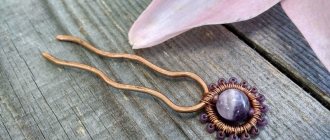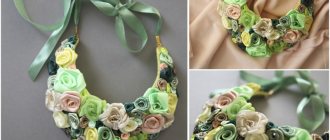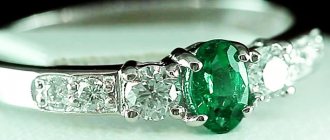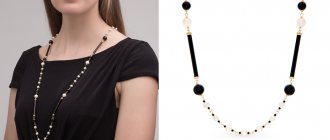Treasures of ancient Rus'
- To date, more than 250 ancient Russian treasures are known;
- Large-scale work on the preservation and study of treasures began in Russia in 1859 under Alexander II;
- The collection of the Russian Museum contains 10 treasures;
- The peculiarity of the collection of the Russian Museum lies in the integrity and safety of ancient jewelry.
| A pot with decorations found in it from the Kyiv treasure of 1893 |
History of ancient Russian treasures
The fate of the ancient jewelry that has come down to us is inextricably linked with the treasures of the 9th-13th centuries, numbering more than 250 today. Especially many treasures were buried during the Mongol-Tatar invasion of 1237. The jewelry found from that time bears traces of fires in the form of burnt and faded enamel. To protect their treasures from plunder, wealthy merchants and boyars buried their wealth in pots, placing them on an ax and covering them with some object, for example, a frying pan.
The first attempts to systematize and preserve antiquities were made by the state back in the 17th century, but large-scale work began with the approval by Emperor Alexander II in 1859 in St. Petersburg of the Imperial Archaeological Commission - the first state institution in Russia conducting archaeological research and participating in the protection of cultural heritage. Since then, ancient jewelry began to be bought back from those who found it and collected for transfer to museums. However, not all relics ended up in state repositories, since many were stolen or simply melted down into precious metals.
| Ryasny. Second half of the 12th century. Kyiv. Gold, pearls; embossing, cloisonne enamel, soldering. |
Treasures in the collection of the Russian Museum
The collection of the Russian Museum today includes a collection of ten ancient treasures, represented by such Slavic jewelry as rings, bracers, neck torcs, temple rings, ochelya, kolta, barma, ryasny. Some items are real masterpieces of ancient Russian jewelry. Ancient craftsmen made jewelry from gold, silver, bronze, copper alloy, and used jasper, pearls, garnet, onyx or heliotrope for inlay.
The peculiarity of the collection of ancient jewelry of the Russian Museum is the integrity of the collection, since many ancient jewelry is presented as a complete set - in pairs: kolta, temple rings. In addition, the collection contains jewelers’ tools – casting molds and dies for embossing jewelry, which are no less valuable and interesting.
| Paired technical bead temple rings, second half of the 12th - first third of the 13th century. Rus. Gold; embossing, filigree, graining, soldering. |
Jewelry art of ancient masters
Ancient jewelers used special techniques:
- filigree - thin gold or silver wires intertwined with each other;
- grains - small metal, usually gold or silver balls;
- cloisonne enamel - a technique borrowed from Byzantium: a pattern in the form of partitions was applied to the surface of the products, and the space between them was filled with enamel, which was fired and polished;
- engraving was also widely used in the manufacture of jewelry and bore images of scenes from life, ritual pagan rites, mythical and real animals and birds.
Some of the most ancient specimens show a clear sign of the influence of Scandinavian culture. This speaks either of their Scandinavian origin, or of the strong influence of the traditions of the jewelry art of Northern Europe on Russian jewelers.
| Pair of collets with images of birds. Front side. First half of the 12th century (?). Kyiv. Gold; embossing, engraving, filigree, mounting, soldering. |
Exhibition at the Russian Museum
From December 16, 2015 to March 16, 2016, the Russian Museum hosted the exhibition “Treasures of Ancient Rus' in the Collection of the Russian Museum.” The exhibition featured more than 400 pieces of jewelry made in different techniques and styles, as well as the tools of ancient jewelers. Despite the fact that the exhibition has already ended, the exhibition catalog, decorated with high-quality illustrations, can still be purchased on the Russian Museum website.
| Barms. Necklace of beads and medallion with the image of a flourishing cross. The end of the 12th - first third of the 13th century. Rus. Silver; embossing, filigree, graining, mounting, soldering, gilding, engraving. |
Literature:
- CM. Novakovskaya-Buchman. Treasures of Ancient Rus' in the collection of the Russian Museum / The Russian Museum presents: Treasures of Ancient Rus' in the collection of the Russian Museum / Almanac. Vol. 457. St. Petersburg: Palace Editions, 2015, ISBN 978-5-93332-525-3
- Imperial Archaeological Commission (1859-1917): To the 150th anniversary of its foundation. At the origins of domestic archeology and protection of cultural heritage / Scientific. ed.-comp. A.E. Musin. Under the general editorship. E.N. Nosova. – SPb.: DMITRY BULANIN, 2009, ISBN 978-5-86007-606-8
We recommend reading
Interview: Alexey Kovalev
Archaeologist, deputy of the Legislative Assembly of St. Petersburg Alexey Kovalev, one of the authors of the law “On treasure hunting,” talks about “searching for treasures,” the use of metal detectors, illegal archaeological excavations, international legislation in the field of protection of archaeological heritage and modern Russian laws.
Further…
All publications
Adolph Dietrich, Paul-Désiré Trouilbert, Willem van Mieris: winter auction 2022 at Schuler Auktionen
From 13 to 17 December 2022, Schuler Auktionen will traditionally hold winter auctions and exhibit a large series of paintings and graphic works by European artists from the 15th to 21st centuries. The top lots are opened by the peaceful landscape “Skating on the Untersee” by Adolf Dietrich (1877-1957), executed in soft pearl shades by the landscape “Carrier in his boat on the river bank” by Paul-Désiré Trouilbert (1829-1900), which has reappeared on the art market 200 years after the last purchase, a biblical story by Willem van Mieris (1662-1747), highly artistic works of the old masters of the Italian school of the 15th-18th centuries. and other unique lots.
Through me. Russian folk jewelry
One day I came across a wonderful article about the history of Russian national costume. As a person who loves such stories, I enthusiastically read the article and enjoyed the beautiful pictures that went with it. In one of the pictures, the eye caught the beautiful, massive earrings that completed the image of a fashionista of her century. And suddenly I thought: “How long ago did jewelry appear in Rus'? Did they mean anything? How have they changed over time? Curiosity took over so much that I had to surrender to his mercy. Let's walk together along the stream of time and admire the works of masters of long-ago, but not forgotten years.
The very first jewelry appeared several tens of thousands of years BC, when the ancient ancestors of modern man, still practically unable to process materials, used pebbles and shells, feathers and seeds donated by nature. Archaeologists believe that at first jewelry did not serve the function of decoration; their purpose was to protect their owner from dangers in hunting and battle, to attract good luck and to earn the favor of the gods. In addition, jewelry of a certain type indicated the special status of its owner. The most popular types of early jewelry were pendants, beads and bracelets - that is, everything that could be assembled from scrap materials by stringing individual elements onto flexible vines or animal sinews.
In Russia, a child’s first piece of jewelry was strings of amulets beads or talisman pendants that protected children from evil spirits . By about 7 years old, children received their second piece of jewelry - earrings. Girls wore earrings in each ear, while boys had one earring. Only eminent citizens wore rings made of gold or silver, while commoners were content with simple rings made of copper and brass.
Temple pendants (Slavs) X - early XII century.
In girls' and women's costumes, various removable jewelry (earrings, bibs, gaitans, back and waist pendants) played a big role. In all regions of Russia they had their own special colors and were made from different materials. The largest center for the distribution of jewelry throughout the country was the Nizhny Novgorod Fair, to which products from almost all jewelry crafts were brought.
The most popular decoration throughout the country were earrings . The earrings were extremely varied. These include solid massive “stuffed cabbage rolls” with pearls, filigree and enamel, which first appeared in the 17th century, and openwork metal ones with glass inserts and noisy round pendants, and all kinds of “double” and “triple” with metal engraved beads, pieces of carnelian, glass , small pearls. Very interesting are homemade earrings from the southern provinces made from goose down, feathers, beads, multi-colored woolen threads, and beads. In the north, the most popular were earrings made of lower mother-of-pearl and pearls, “butterflies”, flat, rosette-shaped, pear-shaped and others.
Earrings 17th century Silver, casting. Russian Ethnographic Museum St. Petersburg, Russia
Earrings “cabbage rolls”, 17th century. Silver, glass; filigree, gilding. Russian Ethnographic Museum St. Petersburg, Russia
Triple and single earrings
Pyasy - from approximately the 14th century, are massive pendants on a ring-shwenze with bells along the lower edge. The earring ring was either attached to the headdress ribbons or attached to the ear. Later they were made from beads.
Pyasy
Koltush (koltushi, kolty) - cast pendants made of gold or silver on ribbons at the temporal part of the headdress, replacing earrings, also served as amulets. It consists of two convex panels, soldered to each other, with a bow at the top for hanging. They are round or star-shaped. The round ones were decorated with images of Sirin birds, the tree of life, flowers, and later Christian motifs.
Colts
Another common type of jewelry was neck and chest : “tongues”, “breasts”, necklaces, necklaces, monistas, gaitans, chains.
Gaitans are products made from small beads and seed beads that descend from the front to the waist and below. They reached greater prosperity at the end of the 19th and beginning of the 20th centuries. in the southeastern part of Russia, among the peoples of the Volga and Urals regions, Siberia. They were made by stringing beads onto one or more threads (sometimes up to 30), manually and woven on a special loom with a thread base. Beads were collected on rough waxed thread, horsehair or thin wire. By interweaving threads with beads strung in a row, craftswomen created bright, colorful patterns, alternating geometric, stylized floral or zoomorphic ornaments. Craftswomen came up with designs for jewelry themselves and borrowed from patterns of woven, wicker and embroidered products.
Gaitana
Monisto
Odnodvorki wore large “ambers” or glass beads , covering the neck in several rows. The northern regions of Russia are characterized by either necklaces of the collar or collar type, tightly fitting the neck and consisting of wide nets made of mother-of-pearl, pearls and white beads, or strips of canvas embroidered with the same materials, complemented by inserts of colored glass and ribbons.
Necklace
Ozherelok (Siberia)
beads and all kinds of metal chains, both voluminous, ringed, and flat, with links made of smooth ribbed or filigree wire, were very popular. The most common were glass beads . Green was considered the most favorite color for beads. Noble women preferred beads made from various materials (gold, pearl and carved from precious stones).
Chain 16th - 17th century. Silver, gilding. Russian Ethnographic Museum St. Petersburg, Russia
Chain fragment
Hryvnias are a type of neck jewelry. Only wealthy ladies could afford metal hryvnias. The most expensive ones were bilon hryvnias - they were made from an alloy of copper and silver, while the most “hit” ones were copper or bronze, sometimes coated with silver.
Hryvnia
And now a few pictures of “fashionistas” from years gone by. Personally, it just takes my breath away looking at this magnificence. And you?
Author - Makovsky K.E.
Author - Sychkov F.V.
I hope you enjoyed our small and beautiful journey through time. Thank you for your attention!
——————————————————————————————————————————————
(All materials are taken from the Internet)
Gorbatov, Samokhvalov, Sitnikov and rare porcelain: autumn auction 2022 at Shapiro Auctions
On December 4, 2022, New York-based Shapiro Auctions will hold a fall auction and present works by Russian, American and European artists of the 20th century, Russian icons, Asian art, art glass, jewelry, ancient artifacts, porcelain, decorative arts, including , Faberge – a total of 827 unique lots. Among the top lots of the Russian part of the auction are “Russian Winter” by Vasily Sitnikov, a portrait of the founder of the school of electric drive of the USSR Sergei Rinkevich by Alexander Samokhvalov, “Jericho” by Konstantin Gorbatov, “Two Women with Ducks” by David Burliuk, “Man in a Hat” by Oleg Tselkov, porcelain mantelpieces IFZ clock from the period of Nicholas I.
Kiev school of making jewelry with cloisonne enamel and the formation of a unified tradition
According to T.I. Makarova, Kyiv craftsmen began producing jewelry with cloisonné enamel in the first half of the 11th century. They used the techniques of Byzantine craftsmen in making series of identical kolta with images of Sirens and birds and decorations in the form of cassocks. There were also single examples of jewelry repeating Byzantine subjects in the form of peacocks - such a subject is depicted on a kolta, distinguished by great craftsmanship.
Scientists believe that the first workshops for the production of cloisonné enamel could have included Russian and Greek craftsmen in the likeness of Greco-Russian glass or mosaic workshops. The first workshops produced high-quality, but stylistically monotonous kolta and cassocks: the design of the products, details, and enamel coloring were repeated. Basically, four primary colors were used: white, blue, red, light green - this once again confirms the opinion that the enamel was purchased in one specific place, most likely in Greek glass workshops in Kyiv.
The workshops were heterogeneous. Some of them produced standard quality jewelry and individual individual masterpieces; others specialized in jewelry with the same style, but of lower quality; still others worked with cheaper material, copper. The latter fact suggests that enamellers appeared among urban artisans.
The traditions of the school of the first enamellers, dating back to the second half of the 11th century, were developed in the next two centuries. Archaeologists discovered treasures that dated back to the second half of the 12th-13th centuries, but the found items with cloisonné enamel repeated the traditions of the first enamellers. The subjects of the images have changed: on the kolta, instead of Sirins and birds, images of saints appeared. B.A. Rybakov explains the change in subjects by the fight against paganism. The ornaments have also changed - they have become more complex, and the color scheme has become more varied. These changes are visible on the floral ornaments of the diadem of the second half of the 12th century depicting the ascension of Alexander the Great. The krin and branch designs are much more complex; the compositions are arranged in a mirror manner, which is reminiscent of the images on the Colts.
Over the century, there have been changes in the assortment of jewelry, which has become richer and more diverse. Regalia for various ceremonies - barmas, crowns and tiaras - were added to women's jewelry. Church decoration became more complicated; Gospel frames with cloisonné enamel frames began to be decorated more richly. An example is the Polotsk cross for church processions, where the image of Saints Stephen and Panteleimon was skillfully laid out using cloisonné enamel. This cross is known for the fact that it preserved the inscription of the master - Lazar Bogsha, the name of the customer - Princess Euphrosyne of Polotsk, and the date of manufacture - 1161.
Finifty contributed to the emergence of a style that B.A. Rybakov called it “enamel” - this is a style of multi-colored ornament, expressed laconically and perfectly. The style of cloisonne enamel was reproduced by artists working with mosaics and miniatures, laying out multi-colored ornaments, clothes and delicate faces on a golden background.
In the second half of the XII-XIII centuries. the drawings of some sets of barmas from the Kyiv group, which preserved the traditions of early enamels, have lost the complexity of execution and the multicolored color scheme.
After systematizing jewelry with cloisonné enamel made in Kyiv workshops, it was possible to identify their features and evolution. The characteristic features of Kyiv enamels include the use of a certain color scheme: blue was the main color, red and white were used in large quantities, green was an additional color. In the middle of the 12th century, which is considered the heyday of Kyiv enamel, the color palette was enriched with new shades and colors: blue was complemented by blue and ash, and new colors appeared - yellow and turquoise.
The subject matter of the images was reduced mainly to the depiction of saints; the previously used techniques were preserved and were complemented by a free manner of drawing, which gave the image greater picturesqueness. The craving for geometric techniques, the main of which were the angle and the cell, also remained.
The preservation of the continuity of traditions in the production of enamel for almost two centuries allows us to conclude that there is a single art school. What factors made it possible to ensure the long-term existence and functioning of such a school?
The appearance of a large number of princely and church regalia, the decoration of boyars and the top of ancient Russian society in archaeological finds with cloisonné enamel provides the answer to this question: the workshops were under the patronage of the authorities. A similar situation of workshops in Byzantium is recorded in many sources: jewelry workshops were state-owned, located on the territory of the emperor’s palace, and artisans attached to the workshops worked there. Their skill and belonging to the jewelry workshop were inherited.
There is no information about state or princely workshops in Russian sources. But the presence of different schools in different lands of Rus' confirms this possibility. An example is the enamel art of the Ryazan principality.
Security Beads and Necklaces
Old Russian pendants and amulets of the 11th–13th centuries. Photo: historicaldis.ru
The Slavs believed in the magical power of jewelry because of its special shape, color and material. For example, beads made from shells and amber were considered amulets because of their “otherworldly”, underwater origin. Different amulets could coexist on one necklace - teeth and animal bones were hung next to Christian crosses.
Protective clothing of the Russian peasant
Ritual costume of the Old Believers.
Nizhny Novgorod State Historical and Architectural Museum-Reserve, Nizhny Novgorod. Photo: samstar.ucoz.ru To protect against evil spirits and the evil eye, peasants performed rituals and used amulets - clothes and jewelry. The Russian costume developed by the 13th century; until the beginning of the 18th century, it was widespread in all classes: in the royal family and among merchants, peasants and artisans. After Peter I introduced European-style dress into use, traditional clothing began to be worn mainly in rural areas.
The basis of women's and men's attire was a long undershirt made of linen or hemp fabric. Women in the southern regions of Rus' dressed in a suit with a poneva - a decorated woolen skirt. In the North they wore a sundress with a shirt, dushegreya and kokoshnik. The hemlines were hemmed with canvas and needles were stuck into them - such a talisman, according to legend, protected a woman from the unwanted attention of men. In everyday life, peasants wore amulets: it was believed that they protected against animal bites and the evil eye.
In addition to festive and everyday clothes, ritual clothing for special occasions was stored in the chests. This costume was distinguished by its color, rich patterns and decorations: women embroidered protective signs and patterns on their shirts. These clothes were worn at the beginning of an important task - sowing, harvesting, building a house.
Corals for sweetheart
Necklaces made of coral beads, cylinders, balls, and barrels were popular among the Western, Southern and Eastern Slavs. There could be from one to 25 threads. One thread was called “one time”.
They made necklaces from opaque glass - patzorki. They came in different colors, from red and blue to black. Round beads were trimmed with gold and painted.
The Slavs attached special meaning to the color red, including its strong protective properties. Therefore, headdresses - kokoshniks, magpies, kiki (ducks), scarves, and scarves were often embroidered with scarlet birds and flowers.
Slavic girls were allowed to wear headbands instead of a massive headdress. Girls wore a headband in the form of a scarlet or embroidered ribbon on their hair, and women wore it over a headscarf. Temple decorations with amulets made of copper, bronze, gold, and silver were often attached to the eyepiece. Archaeologists call such jewelry temple rings.
Burning grass and other useless spring work in the country
Real Knowledge Project: Teachers convey useful information through blogs
An ancient Christian monastery with cells and a church was discovered in Egypt
For soul and body
A mandatory decoration, both everyday and festive, was a neck hoop made of various metals: iron, copper, silver or gold. It was called hryvnia. This word originally meant a necklace, hoop, or decoration worn on the chest. It has been known since the Bronze Age; among the Slavs from the 11th to the 15th centuries it also meant a measure of weight, a coin.
The hryvnia was a talisman that protected the soul and body. Among the Slavs, both women and men wore such a hoop; Russian warriors received a hryvnia as a reward. Since the 16th century, it has been part of the wedding attire of the newlyweds.
Another traditional neck decoration of the Slavs is zgarda. Zgarda was a strong amulet in the form of specific crosses strung on a red base or wire. At the back, the zgardas were connected by chaprags: two disks, which were quite massive in size, with beautiful ornaments.
Among the central elements of decoration was sometimes a galbin - a large iron cross. Galbin could be made with solar signs, rosettes, and spirals. Later, the pagan symbolism of the cross as the cardinal points changed to religious, Christian. Among the Hutsuls, zgardas have been preserved in traditional costume to the present day.
A cat climbs out the window - a housewarming party, and other signs about stray animals
Kuzmich from “Peculiarities of the National Hunt” is married to a young beautiful actress
Russian cosmonauts used tea leaves to discover the location of an air leak on the ISS
Slavic style jewelry: main characters
Jewelry in the Slavic style often contains schematic or very realistic images of horses, bears, wolves, birds, and mythical characters.
For example, in the Silver Beard collection you can find the famous Firebird. This fabulous bird symbolizes not only fire, light and passion, but also success in achieving your goals. The collection includes a pendant with a symbol of free will - a light-winged bird, made of traditional materials: precious stones, silver and gold. Another Slavic women's jewelry is a pendant with a delicate swan, a traditional symbol of tenderness and beauty.










